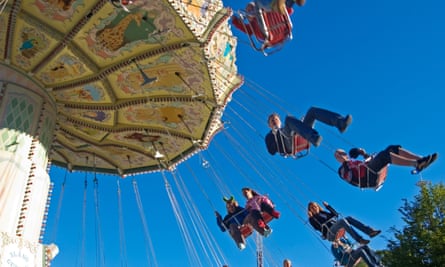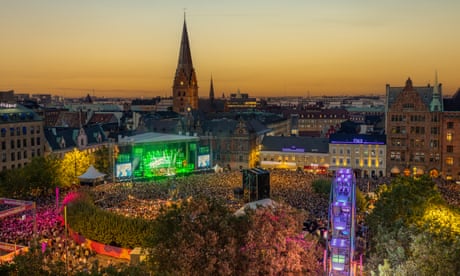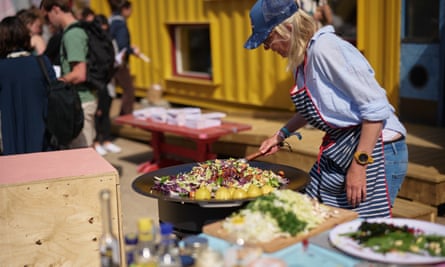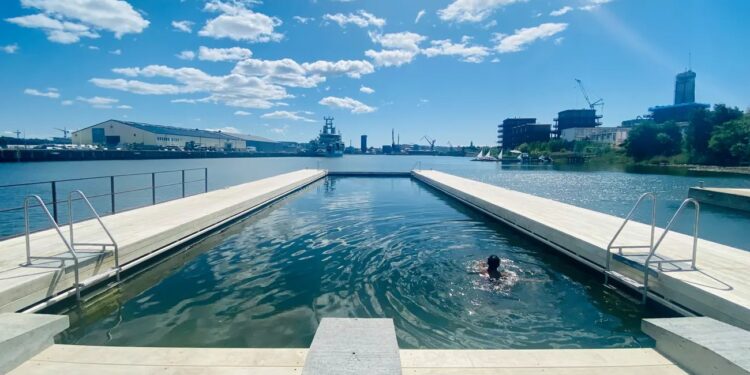Ranked the world’s most sustainable destination, the city has new free swimming pools, extra theme park attractions and is a beacon of Scandi design
It’s a gloriously sunny, if gusty, early-June day at Gothenburg’s new bathing harbour. My son Zac and I are among the first to brave the elements at an open-air complex of swimming and diving pools occupying part of Frihamnen, the city’s docklands that began to fall into disuse in the 1970s.
The unveiling of the pools is part of the city’s 400th-anniversary celebrations, which are taking place throughout the year – delayed from 2021 because of the pandemic. (The same thing happened to its 300-year anniversary plans in 1921 in the aftermath of the Spanish flu pandemic and first world war.) This west coast city began life as a fortified, mainly Dutch, trading colony founded by King Gustavus Adolphus and has grown into Sweden’s main fishing port and second-largest city.
Ten years ago, Gothenburg asked its citizens what they wanted for its 400th anniversary, having given them the Liseberg amusement park to mark the city’s third centenary. This time they said they’d like somewhere to swim in the inner city, not just in the more affluent areas. The day that we are there marks the realisation of that dream.

The pools have no bottom, so they are open to the harbour – there are nets to keep out the seals. But the water is naturally treated and energy efficient, pumping up clean sea water from below the harbour water. Also new at the site are thoughtfully designed children’s playgrounds with giant stone mollusc shells to clamber over, community-minded open-air pop-ups, such as recycling workshops, a DJ pavilion, and changing rooms. What’s more, it’s all free. There is, of course, a sauna too, made from recycling shipping materials (although this is closed for a refurbishment).
I’ve long been a fan of Scandi efficiency, design, progressive parenting and social policies – and cycling – and Gothenburg is a model city in these respects.
Gothenburg will also soon have a one-line metro loop to further reduce car traffic
Everywhere you look, people hurtle along big wide bike paths that crisscross the city. While Zac and I don’t join them, we do spend a Sunday morning pootling around the city’s harbour and Dutch-style canals in a little self-drive electric boat steered by a wooden rudder, ogling the houseboats, old warships and ferries.
When we get back to the centre, we glimpse the king and queen of Sweden arriving at the city hall in a carriage for the anniversary celebrations. Then we stop for a drink on the canal-side terrace of the Havsbaren Tyska Bron.

Hopping aboard the city’s blue trams – some charmingly retro, some modern – is another fun way to get around. Within the next couple of years, Gothenburg will also have a one-line metro loop to further reduce car traffic and take people to its airport. It sounds forward-thinking, but this city has never rested on its laurels: in 2022’s Global Destination Sustainability Index it was named the world’s most sustainable destination, for the sixth time.
It may sound worthy, but Gothenburg, I discover, is a great place to hang out with a teen. My 15-year-old is a theme-park fiend, and one reason we’re here is the opening of the Liseberg Grand Curiosa hotel at the amusement park. Built to look like a traditional pale-brick Gothenburg building, it’s a fairytale property with quirky features such as a vintage carousel in the dining hall, a spiral slide that we slid down from the top floor into the lobby, a Hong Kong-styled restaurant, and a roof terrace with an outdoor meat grill, and view over the rides. From next year, it will also have direct access to Oceana, Liseberg’s water park, which is scheduled to open in May/June.
To Zac’s delight, our corner room looks on to one of the rides: Europe’s longest dive coaster, Valkyria. Grand Curiosa is also stylish – unusual for a theme-park hotel – with botanical or funfair-themed headboards and cute curtained bunk rooms for children. Each floor is individually themed, based on the semi-fictionalised jaunts of 18th-century Gothenburg adventuress Agnes Daler. There is a speakeasy-themed cocktail bar serving adult treats and freakshakes for children, and a reception desk fitted with little windows full of curios to keep small fry entertained while parents are checking in

Also celebrating a big anniversary – its 100th – this year, Liseberg theme park packs a punch with its rides, from fairground classics, such as a ferris wheel, to roaring rollercoasters, including the seven-inversion Helix. Along the way, we refuel on Swedish meatballs, mash and lingonberries at Lisebergs Wärdshus (Zac) and gourmet hotdogs with paprika and garlic sauce at the Korvhallen (me).

Although it’s a 15-minute walk from the centre of the city, Liseberg makes a great base, and two of the city’s best family-friendly museums are here, too. The first is the Världskulturmuseet (Museum of World Culture), where we spend a thought-provoking hour experiencing its new exhibition, which traces the history of play from 4,000-year-old board games to today’s gaming culture (until August 2024). Beside it, Sweden’s national science centre, Universeum, has displays on how the world works, space, technology and sustainability.

Zac and I get a preview of Universeum’s soon-to-be-launched Wisdome, a 360-degree spherical screen that uses the most advanced technology, including live Nasa data, to showcase space travel and more. Its state-of-the-art innards are encased in a wooden shell that has already become a much-loved addition to the city skyline.
We wind up our weekend eating tacos by the harbour, where as part of the anniversary celebrations there is live music, DJ sets, street-food stalls, a climbing wall and high-ropes course. It seems like all Gothenburg is here, proud as punch of their inspiring city – and justifiably so. If only all cities were like this.
Source: The Guardian


Recent Comments